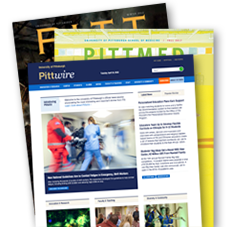Pitt in Brief: News, Awards, and Developments From the University of Pittsburgh
- Pitt’s Swanson School of Engineering ranked among the top two institutions for women PhD grads in compendium of American, Canadian engineering schools
- Pitt-University of Illinois researchers put long-sought knowledge of turbulence on steady ground; has potential for reducing friction in oil pipelines
PITTSBURGH—Behind the larger stories about the University of Pittsburgh are other stories of faculty, staff, and student achievement as well as information on Pitt programs reaching new levels of success. The following is a compilation of some of those stories.
Pitt’s Swanson School of Engineering Ranked Among the Top Two Institutions for Women PhD Grads in Compendium of American, Canadian Engineering Schools
The University of Pittsburgh’s Swanson School of Engineering was ranked second in North America by the American Society for Engineering Education (ASEE) for the percentage of doctoral degrees awarded to women in 2009. Pitt’s Swanson School was positioned just slightly behind the University of Iowa in ASEE’s 2009 Profiles of Engineering and Engineering Technology Colleges published in June. The annual publication provides statistics and profiles for all of the more than 400 engineering schools in the United States and Canada.
Of the PhD degrees the Swanson School awarded last year, 37.5 percent went to female doctoral students, only two percent less than PhD degrees awarded to women at the University of Iowa, according to the report. The ASEE only ranked the 103 institutions that awarded at least 25 PhD degrees last year. The other top 10 universities in this category were Yale, Stony Brook, Duke, the University of Oklahoma, Rutgers, Northwestern, Washington University in St. Louis, and the University of Louisville. Northwestern and Washington universities were tied for 8th place.
Among the Swanson School’s rankings in other significant categories from the report were:
- 20th in industrial and mechanical engineering bachelor’s degrees awarded, and
- 25th in computer engineering bachelor’s degrees awarded.
Pitt-University of Illinois Researchers Put Long-Sought Knowledge of Turbulence on Steady Ground; Has Potential for Reducing Friction in Oil Pipelines
Experiments performed at the University of Pittsburgh in partnership with the University of Illinois at Urbana-Champaign have led to a breakthrough in understanding fluid turbulence, the natural drag produced by flowing liquid that can hamper such processes as transporting oil through pipelines, according to a report recently featured on the cover of Nature Physics.
Walter Goldburg, a professor emeritus in the Department of Physics and Astronomy in Pitt’s School of Arts and Sciences, oversaw the experimental portion of a project that establishes a long-sought link between turbulence and “eddies,” microscopic swirls that impede smooth flow. The theoretical work underlying these experiments was conducted at the University of Illinois by Gustavo Gioia, Nigel Goldenfeld, Tuan Tran, Pinaki Chakraborty, and Nicholas Guttenberg. Experimental work also was performed by Hamid Kellay of the University of Bordeaux.
Any fluid that flows along any boundary–such as oil in a pipeline or water in a riverbank–encounters friction. This friction creates turbulence, which causes a lessened efficiency of flow. The team’s goal was to study the connection between frictional drag and the irregular motion of turbulent eddies in the flow’s interior.
In the experiments, Goldburg and undergraduate and graduate students in his laboratory induced turbulence in a soap film stretched between two wires. By probing the turbulent motion with lasers, they were able to measure the turbulent velocity changes and the frictional drag created at the two wires. This helped them identify how turbulence in a pipe generates the frictional force on the pipe and also how much force the pipe has on the flowing fluid.
The findings have such practical applications as helping to reduce friction in an oil pipeline, Goldburg said. Turbulence can be quite costly because friction leads to heat loss and a decreased flow rate. Understanding how to minimize energy loss by reducing friction and speeding up the process could lead to a reduced cost for delivering oil.
The next step in the project is to examine how the frictional energy loss depends on the roughness of the boundary’s interior wall, Goldburg said. Friction is greater when liquids flow over rough surfaces, a phenomenon the team aims to understand better.
###
Topics
University Units
Media Resources
Schools of the Health Sciences Media Relations
For more information about Pitt's schools of dental medicine, health and rehabilitation sciences, medicine, nursing, pharmacy, and public health, click here >
To locate stories from health science schools prior to 2013, visit the UPMC news archives »
Urgent Question?
University of Pittsburgh news reps are available to answer urgent media inquiries. Outside of regular business hours (Mon-Fri, 8:30 a.m.-5 p.m.), please email us at media@pitt.edu.
News reps for University of Pittsburgh Health Sciences schools can be reached outside of regular business hours through the paging operator at 1+412-647-2345.


